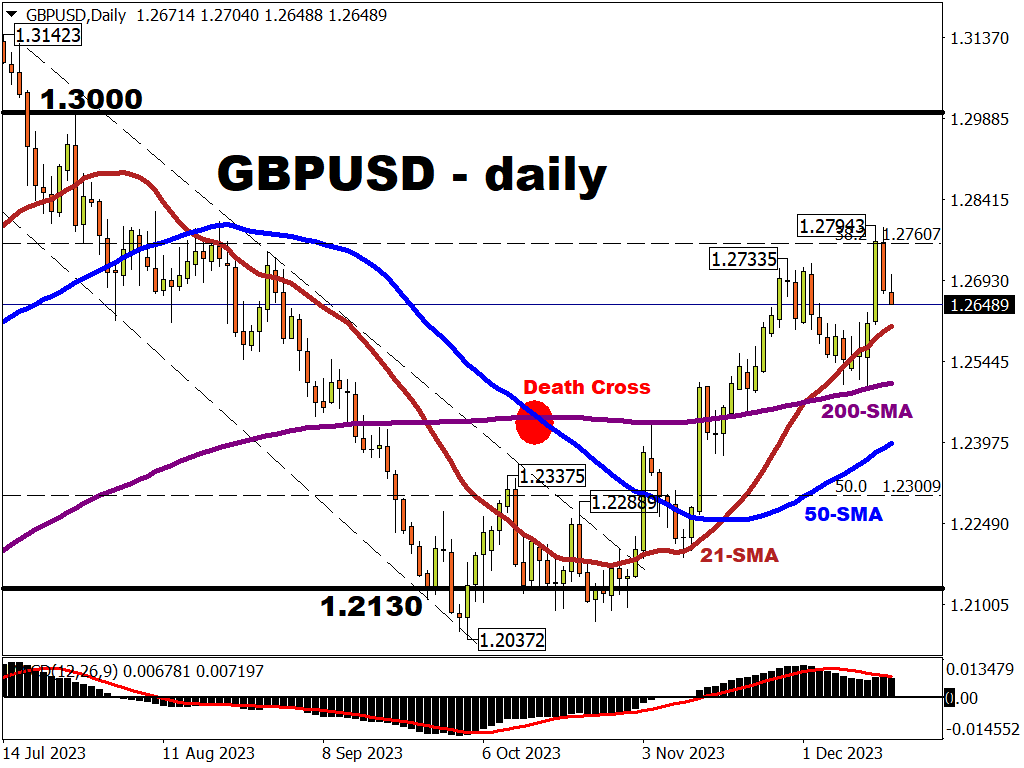Sterling is the second-best performing G10 currency against the US dollar so far in 2023.
At the time of writing, GBPUSD has about 4.9% in year-to-date gains, albeit with a couple of weeks left to go in the year.
The fact that Sterling is stronger against the US dollar so far this year is somewhat remarkable, in light of the UK’s ongoing economic woes.
Still, amid thinning market activity in this year-end period, traders are set to determine whether the year-to-date gains for “cable” (nickname for GBPUSD) will be extended, or thinned out, before 2023 officially comes to a close.
Events Watchlist
GBPUSD traders are set to react to these UK and US economic data to be released later this week:
-
Wednesday, Dec 20th: UK November consumer price index (CPI) – which measures inflation
-
Thursday, Dec 21st: US 3Q GDP (final print)
-
Friday, Dec 22nd: UK November retail sales and 3Q GDP (final print)
-
Friday, Dec 22nd: US PCE Deflator - the Federal Reserve’s preferred way of measuring inflation
For the market’s forecasts for each of the above data points, please refer to the FXTM Economic Calendar.
Why is the economic data important to GBPUSD traders?
Note that traders tend to boost the currency of the country that has higher interest rates.
Hence, markets will be using the data to anticipate what the Bank of England and the Federal Reserve might do to their respective interest rates in 2024.
Recall that, just last week, the Bank of England (BOE) threatened to keep its bank rate higher for longer, which is already at a 15-year high of 5.25%, with the UK central bank apparently still not yet done with its fight against inflation.
In contrast, also last week, the Federal Reserve a.k.a the Fed had forecasted that it will be cutting US interest rates in 2024.
Hence, no surprise that the Pound is about 0.9% stronger against the US dollar since this time last week (Dec 11th).
Potential Scenarios:
GBPUSD could be pushed higher if:
-
the UK inflation data comes in above market forecasts, justifying the BOE’s bias for keeping its bank rate “higher for longer”.
-
post-CPI gains for GBPUSD would have to be sustained by better-than-expected UK retail sales and GDP figures.
- US 3Q GDP remains resilient while the PCE Deflators continue to ease lower, allowing the Fed to cut rates in 2024
However, GBPUSD could be dragged lower by:
-
lower-than-expected UK inflation data, retail sales, and GDP figures that once again highlight the risk of the UK economy falling into a recession.
The greater the damage to the UK economy, the less likely the BOE can afford to sustain its bank rate at this current 5.25% level.
NOTE: Higher interest rates are intended to cool down inflation by destroying demand in an economy. However, interest rates that are too high for too long risks sending an economy into a recession.
- a surprise uptick in the US PCE Deflators that threatens the Fed’s plans to lower US interest rates next year

Key levels
The Bloomberg FX model forecasts a 75% chance that GBPUSD will trade between 1.2528 and 1.2788 this week.
Those levels serve as the general boundaries for GBPUSD’s expected trading range in this week leading up to Christmas.
Within that range, here are some key levels to look out for:
POTENTIAL RESISTANCE
-
1.27335: November 29th intraday high
-
1.27607: 38.2 Fibonacci level from GBPUSD’s long-term (June 2021 till September 2022) descent
- 1.27943: Dec 14th intraday high
POTENTIAL SUPPORT
-
21-day simple moving average (SMA)
- 200-day SMA